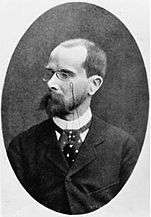Eugène-Anatole Demarçay
Eugène-Anatole Demarçay (1 January 1852, Paris[1] – 5 March 1903, Paris[2]) was a French chemist who designed highly specialized apparatus for use in his research. A specialist in the emerging field of spectroscopy, he detected the presence of the rare earth element europium in 1896, and isolated it as the oxide europia in 1901. He helped Marie Curie to confirm the existence of another new element, radium, in 1898.
Eugène-Anatole Demarçay | |
|---|---|
 Eugène-Anatole Demarçay | |
| Born | 1 January 1852 |
| Died | 5 March 1903 (aged 51) |
| Nationality | French |
| Known for | Spectrum Discovering the element europium |
| Scientific career | |
| Fields | Chemist |
Education
Eugène-Anatole Demarçay was born 1 January 1852 at 152 Haussman, Paris.[2]
Demarçay studied at the Lycée Condorcet, spent time in England, and in 1870[3] entered the École Polytechnique in Palaiseau near Paris.[4][3] There Demarçay studied under Jean-Baptiste Dumas.[1]
He traveled in Algeria, Egypt, and India.[4]
Following his return, Demarçay served for several years as an assistant to Auguste André Thomas Cahours at the École Polytechnique.[2] In 1876, he studied acetylacetonates in the laboratory of Cahours.[2] In 1880 he completed his dissertation, Sur !es acides tetrique et oxytetrique et leurs homologues ("On tetric and oxytetric acids and their counterparts" Gauthier-Villars, 1880).[2] Some of his early organic chemistry researches into terpenes and ether were important for the perfume industry.[3][5]
Career
Demarçay's interests moved from organic chemistry to organometallics and then to inorganic chemistry. He applied for a professorial position at the Academie des sciences in 1878, but was not accepted.[2]
He became particularly interested in studying nitrogen sulfides, publishing three papers in 1880-1881. These compounds appear stable at room temperature, but are sensitive to heat, friction, and shock, and are likely to explode when heated.[2] During an experiment with nitrogen and sulfur, a cast-iron vessel exploded and destroyed the sight in one of his eyes.[3][1]
He established his own private laboratory at 2 Boulevard Berthier, Paris.[2] In 1881-1882, he developed a vacuum system to control temperature during experiments.[2] 1.5 metres high, it consisted of 3 concentric vessels and a compressor driven by a six horsepower gas engine. Temperature in the center vessel could be reduced to 85° below zero.[3] Demarçay used this to study the volatility of substances such as zinc, cadmium, and gold at low temperatures.[2]
Demarçay became a specialist in reading the line patterns of spectroscopy. He developed new techniques for the identification of spectra from rare earth metals.[6] He developed an instrument for obtaining spectra,[2] using an induction coil with pure platinum electrodes to produce a high spark temperature that eliminated impurities that could cause foreign spectral lines. By eliminating sources of error, he made it possible to separate out purer samples of various rare earths than had previously been available.[3][6]
In 1896, he suspected that samples of the recently discovered element samarium were contaminated with another unknown element, predicting that it would be located between samarium and gadolinium. To obtain pure enough samples, he developed a new separation technique involving crystallization of double magnesium nitrate salts. By 1901, he had isolated samples of sufficient purity to confirm the isolation of europium.[3][4][7][8]
In 1898 he used his skills of spectroscopy to help Marie and Pierre Curie confirm the isolation of a new element, radium. After extracting polonium from pitchblende they observed that the remaining sample was still radioacte. They consulted Demarçay, who reported a line in the spectrograph indicative of a new element.[9][1][4]:718–720[10]
Awards
- 1881, Jecker Prix, Section de Chimie de L' Academie des Sciences for contributions to organic chemistry[2]
Family
On 14 November 1889 Demarçay married Jeanne Berard (1865-1933) at the Temple du St. Esprit, Paris, in a Protestant wedding. His granddaughter, Mme. Joseph de Carayon Talpayrac, still lived in Paris in 2003.[2]
Eugène-Anatole Demarçay died 5 March 1903, at his home at 80 Boulevard Malesherbes, Paris. His brother Jean became executor of his estate, and offered the state of the art equipment from his laboratory to Pierre Curie. Curie eventually arranged for it to be given to rare earths researcher Georges Urbain.[2][11]
Publications
- Spectres électriques. Atlas ; Eugène Demarçay ; Paris : Gauthier-Villars, 1895. OCLC 54317437
- Sur les acides tétrique et oxytétrique et leurs homologues ; Eugène Demarçay ; Paris : Gauthier-Villars, 1880. OCLC 25644291
References
- Asimov, Isaac (1982). "825. Demarçay, Eugène Anatole". Asimov's Biographical Encyclopedia of Science and Technology (PDF) (2nd revised ed.). New York etc.: Doubleday. pp. 532–533.
- Marshall, James L.; Marshall, Virginia R. (2003). "Rediscovery of the Elements: Europium-Eugene Demarçay" (PDF). The Hexagon (Summer): 19–21. Retrieved 18 December 2019.
- Etard, A. (March 18, 1904). "The life and work of Eugène Demarçay". The Chemical News and Journal of Physical Science. 89-90: 137–138. Retrieved 19 December 2019.
- Weeks, Mary Elvira (1956). The discovery of the elements (6th ed.). Easton, PA: Journal of Chemical Education.
- Fontani, Marco; Costa, Mariagrazia; Orna, Mary Virginia (2014). The Lost Elements: The Periodic Table’s Shadow Side. Oxford University Press. p. 210-212. ISBN 9780199383344.
- Enghag, Per (2004). Encyclopedia of the elements: technical data, history, processing, applications (1st reprint ed.). Weinheim: Wiley-VCH. pp. 452-. ISBN 978-3527306664.
- Weeks, Mary Elvira (1932). "The discovery of the elements. XVI. The rare earth elements". Journal of Chemical Education. 9 (10): 1751–1773. doi:10.1021/ed009p1751.
- Demarçay, Eugène-Anatole (1901). "Sur un nouvel élément l'europium". Comptes rendus. 132: 1484–1486.
- Malley, Marjorie C. (2011). Radioactivity : a history of a mysterious science. Oxford University Press. ISBN 9780199766413. Retrieved 18 December 2019.
- Daintith, John (1994). "Demarcay, Eugene Anatole". Biographical Dictionary of Scientists. 1st (2nd ed.). Bristol and Philadelphia: Institute of Physics Publishing. p. 219.
- Marshall, James L. Marshall; Marshall, Virginia R. Marshall (2015). "Rediscovery of the elements: The Rare Earths–The Confusing Years" (PDF). The Hexagon: 72–77. Retrieved 30 December 2019.